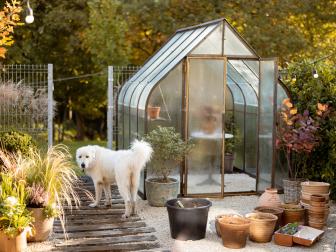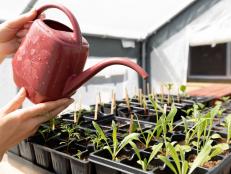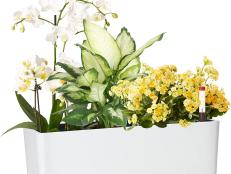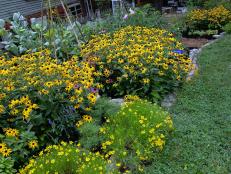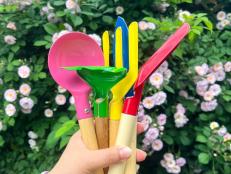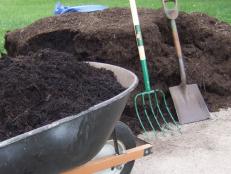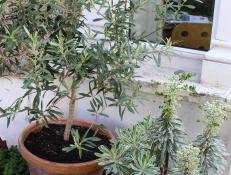How to Heat and Cool a Backyard Greenhouse
Find passive and powered methods for heating and cooling your greenhouse.

A greenhouse’s job is to provide a protective plant-happy environment no matter the weather, so climate control is one of the most important aspects of the setup. Most greenhouses will need assistance keeping the temps within range, but there are ways to design your greenhouse to reduce its need for extra help. Learn how to figure out what your greenhouse needs and what's the latest equipment available. Plus, find out about passive heating methods so you can reduce your need for powered options that cost money to operate.
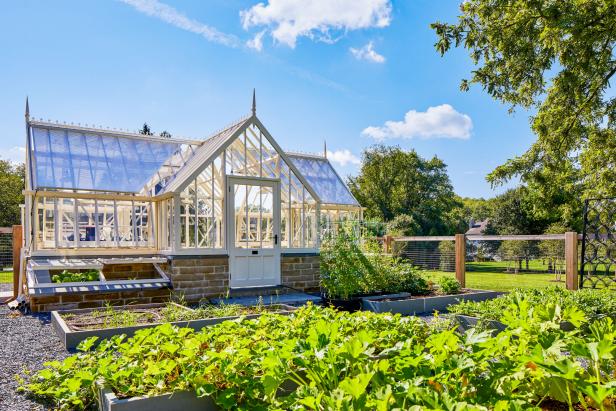
Stacy Zarin Goldberg
Passive climate control methods don’t require power to heat or cool a greenhouse and this large greenhouse incorporates several. The stone knee wall acts as a heat sink, absorbing and retaining excess heat. Exterior roller shades on the roof shade the greenhouse to reduce heat absorption. The front windows are openable to allow for ventilation.
Greenhouse by landscape architects Richardson & Associates.
How to Know What You Need
Your greenhouse heating and cooling needs will fluctuate during the day and, in seasonal climate zones, over the year. Plants have minimum and maximum temperatures they’ll tolerate, along with day and nighttime ideal ranges. Preferences vary during stages of plant growth, too. The equipment you need to keep your temps perfect for your plants will be influenced by:
- the specific requirements of what you’re growing
- your greenhouse size
- your greenhouse construction, specifically the opportunities for heat loss and gain
- your climate — the difference between the minimum outside temperature and the minimum temp inside.
Greenhouses in colder zones may need heating for many months of the year, whereas a warmer zone may not need one at all. Keeping your greenhouse cool is just as important as keeping it warm because too much heat will cook your plants. In addition to their roles in temperature control, ventilation and circulation are crucial for good air quality and controlling humidity levels.
Heating a Greenhouse
Methods for heating a greenhouse include passive techniques and powered heaters and using one does not mean you should ignore the other. Adopting passive heating strategies reduces your need for powered heat. Then, at the coldest times, electric or fuel heaters make up the difference.
Passive Heating Options
Trapping the sun’s heat is part of what a greenhouse is supposed to be about. Passive solar heating incorporates materials that are especially good at absorbing and retaining the sun’s heat (called thermal mass or a heat sink) in the right places so that when the sun’s radiation passes through the glazing and into the greenhouse during warmer daylight hours, that thermal mass sucks up some of the excess heat and stores it. Then, when ambient temperatures drop, the heat is released back into the environment. Additional passive heating strategies will make use of heat being generated in other ways and prevent heat escape through insulation methods.
Here are a few examples of passive heat that can be used in a greenhouse:
- Many greenhouse growers create a dedicated thermal wall. Concrete and stone are options for its construction.
- Water has double the capacity of stone or concrete for heat storage. An easy, inexpensive thermal water wall is made of black-painted water barrels or jugs stacked against a north wall.
- The ground directly under your greenhouse can account for 15% of the space’s heat loss when uninsulated; conversely, insulating the foundation around a greenhouse floor turns it into a heat sink. Colorado greenhouse designer Ceres Greenhouse Solutions explains two popular methods of insulating a cement foundation in a great primer on the topic.
- A climate battery, also called a ground-to-air heat exchanger, maximizes the floor’s capabilities as thermal mass. When it’s hot, fans transfer excess warm, humid air from your greenhouse into a one-way network of plastic tubing you’ve installed a few feet underground, giving back cooler air in the process. When temps drop, the climate battery works in reverse — pushing the hot air you’ve stored in the ground back into the space and pulling the cold air from your greenhouse underground for heating. This tech isn’t entirely passive since it requires fans to operate, but it is very low-cost to set up and run.
- A rocket mass heater is a DIY wood-burning stove that magnifies its heating capabilities by circulating its hot exhaust air through thermal mass like a greenhouse bench or floor made of brick or rock. A rocket mass heater is powered by wood, but as a sustainable fuel, some growers find it preferable. This HGTV how-to shows how to make a terra-cotta heater that works on the same concept.
- A compost-pile heater is a way to use the heat being generated during decomposition that would otherwise be going to — well, waste! The simplest compost heater is a pile or bin strategically placed within the greenhouse to warm a particular area. A more advanced system has embedded water pipes in a large compost pile against an outside wall that circulates the pile’s heat into the greenhouse. Interior compost piles will also raise carbon dioxide levels, which will thrill your plants.
- As with greenhouse floors, sufficient insulation goes a long way to ensure you aren’t losing heat. Similarly, in plant beds, using mulch acts as a soil insulator. The biggest area of heat loss in a greenhouse is usually the glazing. That lovely heat you trapped inside your space during the day leaves when temps drop outside. Installing insulation blankets, wraps and curtains can prevent a significant amount of heat loss. Some styles are rolled down at night; others are applied seasonally.
- Finally, you can also organize your greenhouse in a way that will reduce your need for supplemental heating. You can use a thermometer to identify naturally occurring hot and cold spots in your space and locate your plants according to what they want, creating climate zones instead of raising the entire greenhouse temperature. For example, because seeds need more warmth, use germination mats that heat the bottom of a seed tray as a localized way to heat a particular area. Some growers use that power-free compost-pile heater similarly, by creating a frame for seed trays on top of a bed or bin of compost.
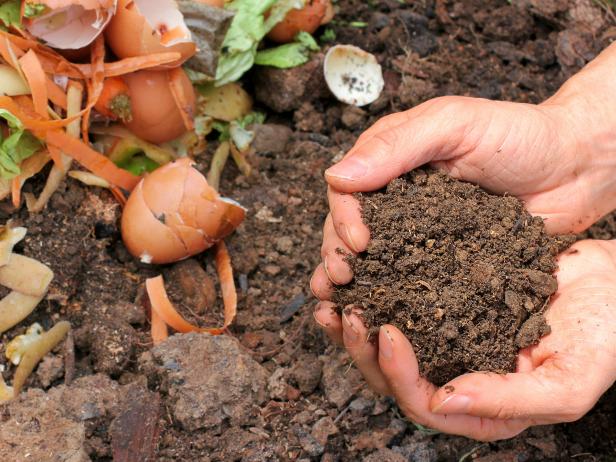
iStockphoto.com/terra24
A compost pile provides free heat to your greenhouse, a byproduct of decomposition. Plants also love the carbon dioxide generated.
Powered Heating Options
There are a few technologies used for greenhouse heating: fan heaters that heat air and blow it into the space, radiant heaters that heat objects instead of the air and convection heaters that warm a space by capitalizing on the natural inclination of heat to rise and cold air to sink. There are also combo technologies. Greenhouse heaters can be electric or run on a fuel such as natural gas, propane, coal, oil, wood or biomass.
Powered heating solutions range in size from those that target particular plant beds to thermostat-controlled central boilers and furnaces for large spaces. Many home greenhouses can make do with the in-between — space heaters. But since a greenhouse is an enclosed, frequently unattended and wet space, stick with space heaters that are intended specifically for the greenhouse environment, with moisture protection and the appropriate safety shutoffs for the technology — for example, overheating, tipping and low oxygen levels.
As mentioned earlier, the specific requirements of what you’re growing, your climate, your greenhouse size and construction will determine the size of the heater you need. Gather those details together and your greenhouse supply company can help you figure it out. Options will include:
- Bed-specific radiant heaters like electric soil heating cables and mats are placed within plant beds to provide a small amount of constant heat to soil. Price range $10 to $50.
- Fan-operated electric space heaters warm the air by pushing it across a heated metal element. The fan provides air circulation, which is a big greenhouse plus. These heaters often have a fan-only setting making them useful year-round. Electric fan heaters are cheap to buy and very efficient, but the operating cost will depend on what you pay for electricity. Price range: $60 to $250.
- Infrared heaters provide radiant heat. They come in portable standing units and models that mount on walls or hang from the ceiling above beds. They are inexpensive heaters to operate since they don’t waste energy heating the air but will need to be paired with a fan if you want ambient heat. Price range: $120 to $400
- Electric portable oil-filled radiators are part radiant, part convection so they heat the air more than an infrared heater. They come with some protections (from tip-over and overheating), but we couldn’t find one that wanted to be splashed with water. They also don’t heat up or cool off quickly. Price range: $70 to $150
- Unvented space heaters, also called clean-burning, are fuel-powered versions of some of the space heating technologies we’ve mentioned. Fuel-powered heaters can be handy for emergency heat since they don’t require electricity, but for regular operation — well, these units are not for the jittery. When dirty or not working properly, they can release noxious fumes into the greenhouse that are unhealthy not just for plants but for growers. They require oxygen to operate and will shut off without a sufficient supply. The tradeoff is the operation cost if fuel is significantly cheaper than electricity in your area. Price range: $150 to $270.
- Unit heaters operate like a forced-air furnace, using a heat exchanger and fan to supply and distribute hot air to larger greenhouses. They are usually mounted close to the ceiling and increase the temperature quickly. There are several types of these heaters, and whether they run on electricity or fuel will determine their efficiency and cost. Natural gas may be more expensive to hook up initially and the system must be vented, but the heaters are inexpensive to operate, reliable and very efficient. If your greenhouse is attached to your home, it can reduce the setup costs substantially. Price range: $1,000 and up.
- Hot-water or steam heating systems use a boiler outside the greenhouse that is powered by fuel (wood, coal, gas or oil) to move heated water or steam through pipes installed in the greenhouse floor, overhead, in benches or plant beds. Water is more efficient than steam and the operating cost of the boilers depends on the fuel source. Boilers are primarily radiant, so they take time to raise and lower greenhouse temperatures. But hydronic forced-air unit heaters operate by transferring the heat from the steam or hot water to the air, giving you the best of both worlds. These systems are more common in very large greenhouses. Price range: $2,000 and up.
- Geothermal systems make use of naturally occurring heat pockets deep underground, either by circulating hot spring water boiler-style or moving hot air processed by a heat pump in a forced-air system. Geothermal is fantastically efficient, but the systems are only feasible in some areas of the country, and their cost varies widely based on local availability. Price range: $3,000 and up.
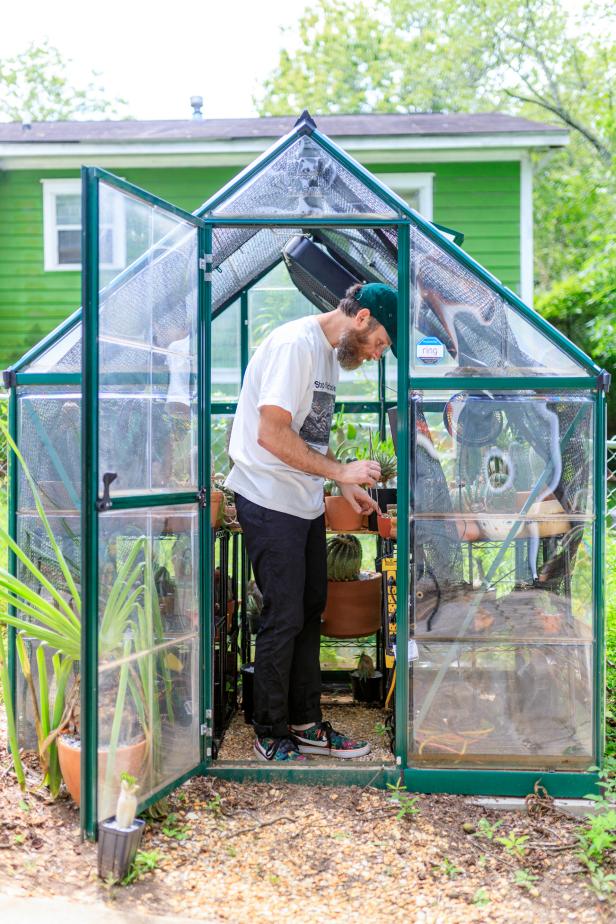
Tomas Espinoza
This small greenhouse incorporates interior shade cloth to reduce heat absorption, roof and wall vents to allow heat escape and a fan to aid in ventilation and circulation for the desert plants inside.
Home greenhouse built by the owners of The Victorian Atlanta plant store.
Cooling, Ventilation and Circulation
Cooling a greenhouse is about actively reducing the temperature as well as passively preventing the temperature from maxing out to begin with. Ventilation and circulation are part of your cooling strategy but are also imperative for good air quality. Proper ventilation year-round ensures that plants have the carbon dioxide and humidity levels they are happy with. Circulating air within the greenhouse eliminates hot and cold spots and controls moisture, too. The strategies for this part of your climate control might include the following:
- The thermal mass you’ve incorporated into your greenhouse. It should take some of the excess heat from the space and give it back when it’s cooler at night.
- Your greenhouse interior design. Placing freestanding shelves away from the sides of the greenhouse allows for air circulation around them.
- Using roll-up screens and film shades can help you control the amount of heat your greenhouse absorbs to begin with.
- Installing roof and side vents will encourage airflow.
- Use powered exhaust fans to move hot air out that’s already in the greenhouse.
- Making use of horizontal air flow (HAF) fans — a series of fans mounted at the ceiling directing airflow — will aid in circulation.
- An evaporative cooling system uses an exhaust fan to move hot greenhouse air across a wet pad before giving it back cooler. This keeps the temperature down, humidifies the air and helps keep inside air circulating, all key ingredients for healthy plants. But if you live in an already-humid climate, this cooling method isn’t for you.
In a simple system, shuttered intake vents let in cooler air from outside when an exhaust fan mounted near the roofline on the opposite end of the greenhouse is activated by a thermostat.
Final Thoughts
Your goal may be to have an entirely self-sustaining greenhouse, but low winter temperatures thwart your efforts to use passive strategies alone. Solar photovoltaic (PV) panels placed on the home or in the yard may generate the electricity needed to power a supplemental heater or fans. The power is free once you buy in, but that initial setup for panels, battery storage and connection can be costly. Further, a PV installation requires space for the solar collectors. Since your greenhouse roof is spoken for, you’ll need space in the yard or on top of the home. A wiser approach may be to create the most fabulous, energy-efficient greenhouse you can and then buy into a community solar project for the small amount of electricity needed to supplement your efforts.
Helpful Sources
- Find a community solar project near you on the EnergySage website.
- ACF Greenhouses in Virginia has useful greenhouse calculators on its website, including one for estimating the size heater your space requires.
- Mother Earth News explains ways to heat your greenhouse for free here.
- Ceres does a deep dive into the untapped heat in your greenhouse floor here.
- The University of Georgia Extension Office has a helpful publication with free greenhouse plans.
Finish Setting Up the Greenhouse
Choosing a Greenhouse
Careful planning will pay off when selecting and putting up a greenhouse.
Water and Lighting in a Greenhouse
Water and light are essential to plants, and in a greenhouse, you'll provide both.
10 Backyard Greenhouses You Can Buy Online
Keep your green thumb occupied and protect your plants from the elements with these greenhouse finds.






